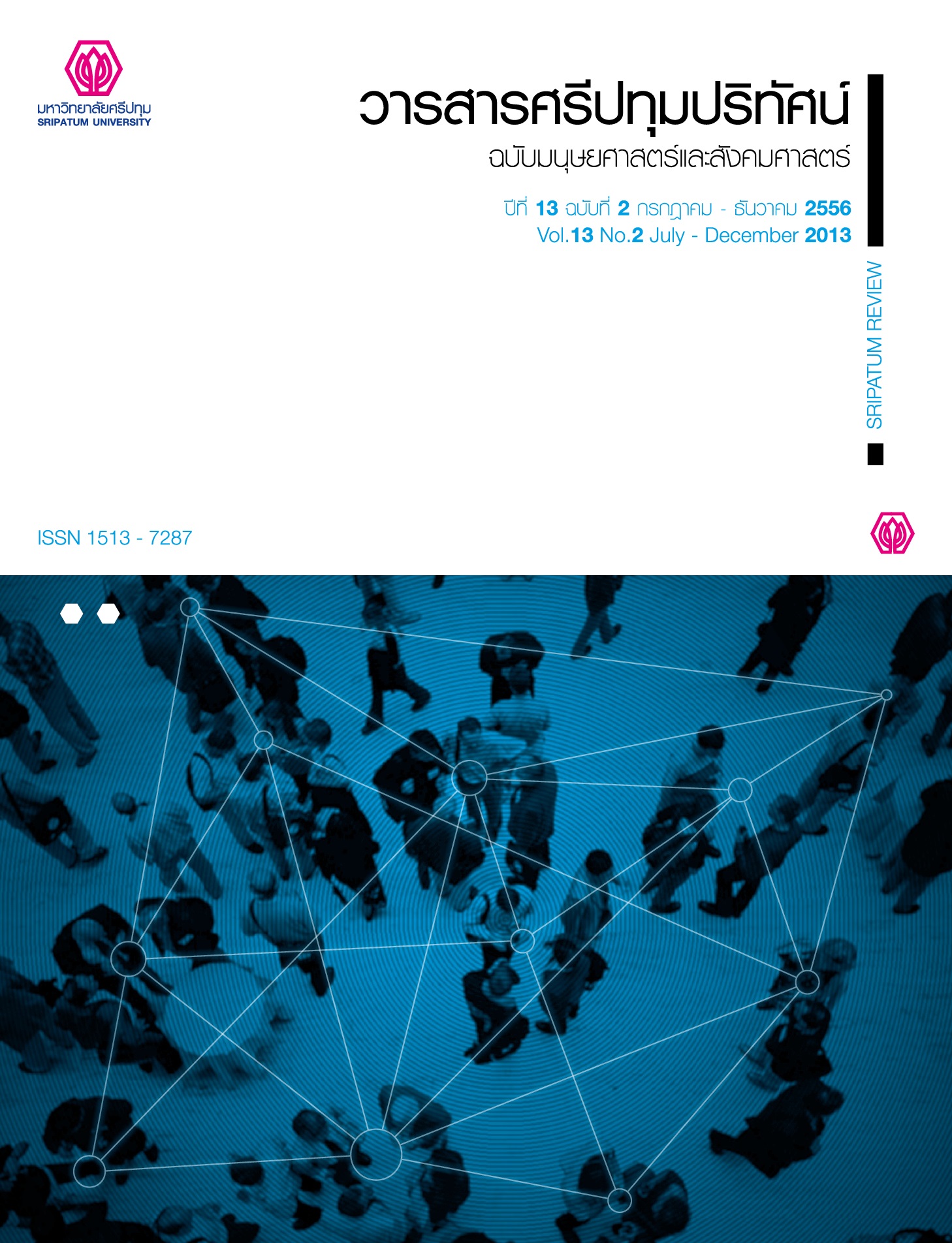THE ROLE OF PRAGMATICS IN TEACHING ENGLISH FOR OCCUPATIONAL PURPOSES FOR THAI LEARNERS
Main Article Content
Abstract
This article aims at introducing fundamental concepts of pragmatics related to speech acts, cooperative principle, and linguistic politeness in teaching English for Occupational Purposes (EOP) for Thai learners, and suggesting factors that the teacher needs to consider in presentation of contents on pragmatics. The contents of this article are based on pragmatics concepts and studies related to English for Occupational Purposes, with the exclusion of contrastive or cross-cultural aspects of pragmatics.
Article Details
1. กองบรรณาธิการสงวนสิทธิ์ในการพิจารณาและตัดสินการตีพิมพ์บทความในวารสาร
2. บทความทุกเรื่องจะได้รับการตรวจสอบทางวิชาการโดยผู้ทรงคุณวุฒิ แต่ข้อความและเนื้อหาในบทความที่ตีพิมพ์เป็นความรับผิดชอบของผู้เขียนแต่เพียงผู้เดียว มิใช่ความคิดเห็นและความรับผิดชอบของมหาวิทยาลัยศรีปทุม
3. การคัดลอกอ้างอิงต้องดำเนินการตามการปฏิบัติในหมู่นักวิชาการโดยทั่วไป และสอดคล้องกับกฎหมายที่เกี่ยวข้อง
References
Austin, J. L. (1962). How to do things with words. Oxford: Clarendon Press.
Bachman, L. (1990). Fundamental considerations in language testing. Oxford:Oxford University Press.
Bardovi-Harlig, K. (2001). Evalutaing the empirical evidence: Grounds for instruction in pragmatics? In G. Kasper & K. Rose (Eds.),Pragmatics in language teaching. (pp 13-60). Cambridge: Cambridge University Press.
Batch, T. (2004). Pragmatics and philosophy of language. In Laurance R. H. and Gregory W. (Eds.), The Handbook of Pragmatics. Oxford: Blackwell.
Baker, S., Bradley, P., & Huyton, J. (2002). Principles of hotel front office operations. Singapore: Seng Lee Press.
Blue, G.M., & Harun, M. (2003). Hospitality language as a professional skill. English for Specific Purposes, 22, 73-91.
Boxer, D., & Pickering, L. (1995). Problems in the presentation of speech acts in ELT materials: The case of complaints. ELT Journal 49, 44-58.
Brown, P., & Levinson, S. (1987). Politeness: Some universals in language usage. Cambridge: Cambridge University Press.
Cohen, A. D. (2008). Teaching and assessing L2 pragmatics: What can we expect from learners? Langauge Teaching, 41 (2), 213-235.
Cutting, J. (2011). English for airport ground staff. English for Specific Purposes, 31, 3-13.
Grice, H. P. (1975). Logic and conversation. In P. Cole & J. Morgan (Eds.), Syntax and Semantics. Vol 3: Speech Acts, 41- 58. New York: Academic Press. Urbana, IL: University of Illinois.
Harding, K., & Henderson, P. (1994). High season: English for the hotel and tourist industry. Oxford: Oxford University Press.
Jiang, Xiangying. (2006). Suggestions: What should ESL students know?. System, 34, 36-54.
Jordan, R.R. (1997). English for academic purposes: A guide and resources book for teachers. London (UK): Cambridge University Press.
Judd, E. L. (2009). Some issues in the teaching of pragmatics competence. In E. Hinkel (Ed.),Culture in second language teaching and learning, (pp 152- 166). New York: Cambridge University Press.
Kasper, G. (1997). The role of pragmatics in language teaching education. In K. Bardovi-Harlig & S. B. Hartford (Eds.), Beyond methods: Components of second language teacher education. New York: McGraw-Hill.
Lakoff, R. (1973). Language and woman’s place. Language in Society, 2 (1), 45-80.
Koester, A. J. (2002). The performance of speech acts in work place conversation and the teaching of communication functions. System, 30, 167-184.
Leech, G. (1983). Principles of pragmatics. Harlow, England: Longman.
Murtagh, A. (2002). Could you repeat that?: Developing L2 pragmatic awareness for business meetings in an EFL context. Thai TESOL Bulletin, 13 (1), 14-25).
Searle, J. (1976). A classification of illocutionary acts. Langague in Society, 5, 1-23.
Vandermeeren, S. (2005). Foreign language need of business firms. In H. Michael. (Ed.), Second language needs analysis, (pp. 169-181). Cambridge: Cambridge University Press.
Widdowson, H. G. (1998). Communication and community: The pragamtics of ESP. English for Specific Purposes,17, 3-14.
Williams, M. (1988). Language taught for meetings and langauge used in meetings: Is there anything in commond?. Applied Linguistics, 9 (1), 45-58.


